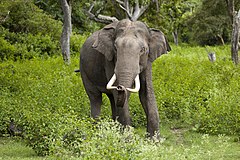Elephas
| Elephas[1] | |||
| Linnaeus, 1758[2] | |||
 Przedstawiciel rodzaju – samiec słonia indyjskiego (E. maximus) | |||
| Systematyka | |||
| Domena | |||
|---|---|---|---|
| Królestwo | |||
| Typ | |||
| Podtyp | |||
| Gromada | |||
| Podgromada | |||
| Infragromada | |||
| Rząd | |||
| Rodzina | |||
| Rodzaj | Elephas | ||
| Typ nomenklatoryczny | |||
Elephas maximus Linnaeus, 1758 | |||
| Synonimy | |||
| |||
| Gatunki | |||
| |||
Elephas – rodzaj ssaka z rodziny słoniowatych (Elephantidae).
Zasięg występowania
Rodzaj obejmuje jeden żyjący współcześnie gatunek występujący w południowej i południowo-wschodniej Azji[4][5][6].
Morfologia
Długość ciała (włącznie z trąbą) 550–640 cm, długość ogona 120–150 cm, wysokość w kłębie samic 240–250 cm, samców 270–340 cm; masa ciała samic około 2720 kg (maksymalnie do 4160 kg), samców około 3600 kg (maksymalnie do 6000 kg)[5].
Systematyka
Etymologia
Podział systematyczny
Do rodzaju należy jeden występujący współcześnie gatunek[4][8]:
- Elephas maximus Linnaeus, 1758 – słoń indyjski
oraz gatunki wymarłe:
- Elephas beyeri von Koenigwald, 1956[9]
- Elephas celebensis (Hooijer, 1949)[10]
- Elephas ekorensis Maglio, 1970[11]
- Elephas hysudricus Falconer & Cautley, 1845[12]
- Elephas hysudrindicus Dubois, 1908[13]
- Elephas iolensis Pomel, 1895
- Elephas platycephalus Osborn, 1929
Uwagi
- ↑ Niepoprawna późniejsza pisownia Elephas Linnaeus, 1758.
Przypisy
- ↑ Elephas, [w:] Integrated Taxonomic Information System [online] (ang.).
- ↑ C. Linnaeus: Systema naturae per regna tria naturae, secundum classes, ordines, genera, species, cum characteribus, differentiis, synonymis, locis. Wyd. 10. T. 1. Holmiae: Impensis Direct. Laurentii Salvii, 1758, s. 33. (łac.).
- ↑ É. Geoffroy Saint-Hilaire & G. Cuvier. Mémoire sur une nouvelle division des Mammifères, et sur les principes qui doivent servir de base dans cette sorte de travail, lu à la société d’Histoire naturelle, le premier floréal de l’an troisième, par les citoyens. „Magasin Encyclopédique”. 1 (2), s. 189, 1795. (fr.).
- ↑ a b C.J. Burgin, D.E. Wilson, R.A. Mittermeier, A.B. Rylands, T.E. Lacher & W. Sechrest: Illustrated Checklist of the Mammals of the World. Cz. 1: Monotremata to Rodentia. Barcelona: Lynx Edicions, 2020, s. 118. ISBN 978-84-16728-34-3. (ang.).
- ↑ a b G. Wittemyer: Family Elephantidae (Elephants). W: D.E. Wilson & R.A. Mittermeier: Handbook of the Mammals of the World. Cz. 2: Hoofed Mammals. Barcelona: Lynx Edicions, 2011, s. 79. ISBN 978-84-96553-77-4. (ang.).
- ↑ D.E. Wilson & D.M. Reeder (red.): Genus Elephas. [w:] Mammal Species of the World. A Taxonomic and Geographic Reference (Wyd. 3) [on-line]. Johns Hopkins University Press, 2005. [dostęp 2020-10-30].
- ↑ T.S. Palmer. Index Generum Mammalium: a List of the Genera and Families of Mammals. „North American Fauna”. 23, s. 225, 1904. (ang.).
- ↑ Nazwy polskie za: W. Cichocki, A. Ważna, J. Cichocki, E. Rajska-Jurgiel, A. Jasiński & W. Bogdanowicz: Polskie nazewnictwo ssaków świata. Warszawa: Muzeum i Instytut Zoologii PAN, 2015, s. 24. ISBN 978-83-88147-15-9. (pol. • ang.).
- ↑ G.H.R. von Koenigwald: Fossil mammals from the Philippines. Quezon City: National Research Council of the Philippines, 1956, s. 12. (ang.).
- ↑ D.A. Hooijer. Pleistocene vertebrates from Celebes: IV. Archidiskodon celebensis nov. spec.. „Zoologische mededelingen”. 30 (14), s. 206, 1949. (ang.).
- ↑ V.J. Moglio. Four new species of elephantidae from the Plio-Pleistocene of northwestern Kenya. „Breviora”. 341, s. 20, 1969–1970. (ang.).
- ↑ H. Falconer & P. Cautley: Fauna antiqua sivalensis, being the fossil zoology of the Sewalik Hills, in the north of India. London: Smith, Elder and Co, 1846, s. 6, ryc. 5. (ang.).
- ↑ E. Dubois. Das geologische Alter der Kendeng- oder Trinil-Fauna. „Tijdschrift van het Koninklijk Nederlandsch Aardrijkskundig Genootschap”. 2, s. 1235–127, 1908. (niem.).
Media użyte na tej stronie
Autor: (of code) -xfi-, Licencja: CC BY-SA 3.0
The Wikispecies logo created by Zephram Stark based on a concept design by Jeremykemp.
Autor: Yathin S Krishnappa, Licencja: CC BY-SA 3.0
Indian elephant bull in musth in Bandipur National Park

